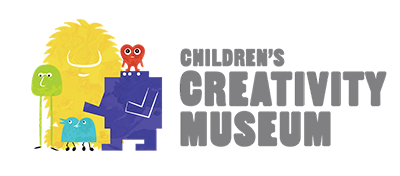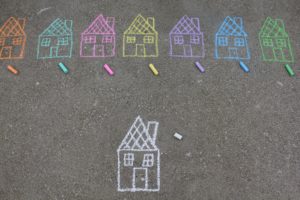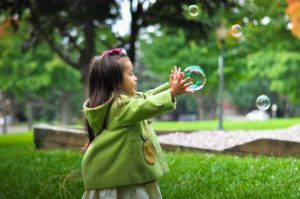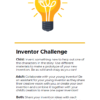By Maureen (Mo) Weinhardt, Education Manager
***
One of the worst things I’ve heard come out of an adult’s mouth at CCM:
“No, no, I can’t do it, I’m not very creative. I’ll just help [insert child’s name] instead.”
Noooooooooooooooooo!
How have so many adults convinced themselves that they aren’t “creative”? Why do so many people deny themselves the opportunity to participate in fun, hands-on, original forms of self-expression?
Well… I used to be one of those adults. I know from personal experience how this can happen. It was easy and natural for me to encourage creative thinking and problem-solving in students and families, but I had strangely different rules for myself. I was afflicted by something called a “fixed mindset”. Thankfully my work at CCM has helped me internalize a better frame of mind, one that we hope to share with others in our community and beyond.
In her book Mindset: The New Psychology of Success, Stanford University psychologist Carol Dweck, Ph.D. explores how people’s beliefs about themselves (our talents, abilities, intelligence, creativity, etc.) have a direct impact on our success. We become what we believe about ourselves.
For example, I grew up with what is known as a “fixed mindset”. I grew up believing that my intelligence, talents, creativity etc. were static, intrinsic, and could not be improved – only validated and affirmed by others. The limitations I placed on myself were completely unnecessary, and I wasn’t even aware I was doing it.
Well-intentioned parents and teachers often tell children how smart they are instead of praising and reinforcing the skills of effort, growth, or follow-through. For me, this resulted in “smartness” becoming an important part of my identity. The serious downside of this was that any time I came across a challenging activity or subject in school that threatened this part of my identity, I would give up easily and move on to something else. I lacked true resilience, and avoided any risk-taking that might threaten my self-image of “being smart”.
Another belief I carried with me from a young age was that I was not creative. I could not draw or paint realistically; I didn’t stand out in art class; I loved to write, but somehow that wasn’t enough for me to identify as creative. By the time I reached adulthood, I had absorbed a very narrow definition of creativity and believed that it was most certainly not part of my identity.
Thankfully, this all began to change when I came to the Children’s Creativity Museum and learned how to intentionally foster a “growth mindset” in myself and others.
A growth mindset is the belief that every person’s abilities, intelligence, creativity and more can be cultivated and improved. Although I was a powerful advocate of this belief in others, I did not actually believe that it was true for me too. My first year at the museum was very eye-opening!
People with a growth mindset are not afraid of failure. They thrive on challenge, growth, and learning from mistakes. They embrace the process of learning over the product. They fail forward, learning and improving every step of the way.
“I have not failed. I’ve just found 10,000 ways that won’t work.” ~Thomas Edison
One of my favorite examples of this mindset is a young boy named Audri, who created a Rube Goldberg monster trap. I first saw this in a professional development training at the museum called Failing Forward – this video is worth watching! Audri embodies the growth mindset, and is a remarkable example of what Educators aim to nurture through our interactive exhibits and hands-on programming at CCM.
CCM’s educational philosophy revolves around a simple yet potent learning process:
Imagine – Create – Share.
These elements are active in all of our educational programming and interactive exhibit spaces. The ultimate goal of our ed philosophy is to develop creative confidence, which we define as:
“Having the freedom and courage to fail/take creative risks, and the knowledge that all of the ideas you create have value.”
This goal is not just for the children who visit our museum – it is for all of the adults as well! (After all, how can we teach things to others if we can’t do it ourselves?) Building your own creative confidence, and nurturing it in the children you love, requires a growth mindset. To help you move in that direction, here are three ways to unleash your own creativity and help kids do the same:
- Notice your mindset. Are you opting out of something because you’re afraid of making a mistake? Are you speaking negatively about yourself, saying “I can’t” or “I’m not good at [math/art/whatever]?” The first step is simply noticing what your habits of mind are. If you’re not aware that you’re limiting yourself, there’s no opportunity to do things differently or take a creative risk. Also – and this is important – when you say such things around children, they often absorb the same limitations.
- Make experiences fun & collaborative. Stay light-hearted! Learning is a process and mistakes are a crucial part of that process – not something to be feared. It also helps to do activities/projects with others, making it a shared experience. Playful moods are contagious, and make it easier to laugh and take risks. You have the power to set this tone for yourself, essentially giving others (children and adults alike) permission to do the same.
- Focus on the process over the product. Whether you’re creating a stop-motion animation movie, learning to code robots, doing a science experiment, or making a sculpture, the journey is far more important than the destination. That is where real learning and bonding happens. Don’t lose sight of this: it’s the process of Imagine – Create – Share that truly builds creative confidence, not the end result.
If you intentionally practice these three things, you will begin to notice a shift toward a growth mindset – one that I have found to be deeply rewarding. This has not only helped me recognize my own creative potential; it has profoundly impacted my work in education and the positive impact I can have on others.
Test this for yourself and see what happens. Instead of “I can’t”, try saying “I’m not sure how to do this, but let’s give it a try!” What do you notice? What happens when you’re aware of your mindset, intentionally more light-hearted and collaborative, and focus on the process over the product? I’m excited for you to find out. Share your stories, observations, and photos below in the comments – help us learn from one another!
Watch this TED Talk by Carol Dweck to learn more about the growth mindset.






